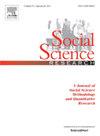学校作业联系的国内差异:以以色列为例
IF 3.5
2区 社会学
Q1 SOCIOLOGY
引用次数: 0
摘要
教育成果和职业之间联系的强度和结构影响着教育和劳动力市场的结果,但这些联系的特征和后果可能因种族、民族、宗教和性别定义的人口群体而系统性地变化。对阿拉伯和犹太工人、米兹拉奇和阿什肯纳兹工人以及以色列男性和女性工人的联系结构的比较表明,虽然教育证书和职业目的地之间的紧密联系往往是有利的,特别是在高等教育的专业研究领域,但这些途径也可能限制机会,而且当劳动力市场按性别和/或种族划分时,情况就不同了。教育和职业的边际分布,教育和职业之间的关联强度,以及劳动力市场的灵活性,允许从教育到职业结果的非规范路径,都在定义以色列案例中的群体优势和劣势模式方面发挥了作用。本文章由计算机程序翻译,如有差异,请以英文原文为准。
Within-country differences in school-work linkages: The case of Israel
The strength and structure of linkages between educational outcomes and occupations affects both educational and labor market outcomes, but the characteristics and consequences of these linkages can vary systematically across population groups defined by race, ethnicity, religion and gender. A comparison of linkage structure for Arab and Jewish workers, for Mizrachi and Ashkenazi workers, and for male and female workers in Israel reveals that while strong linkages between educational credentials and occupational destinations are often advantageous, particularly for professionally oriented fields of study in tertiary education, these pathways can also restrict opportunity and differently so when labor markets are organized on gender and or ethnic lines. The educational and occupational marginal distributions, the strength of associations between education and occupation, and labor market flexibility allowing non-normative pathways from educational to occupational outcomes all play a role in defining the pattern of group advantage and disadvantage in the Israeli case.
求助全文
通过发布文献求助,成功后即可免费获取论文全文。
去求助
来源期刊

Social Science Research
SOCIOLOGY-
CiteScore
4.30
自引率
4.00%
发文量
0
审稿时长
65 days
期刊介绍:
Social Science Research publishes papers devoted to quantitative social science research and methodology. The journal features articles that illustrate the use of quantitative methods in the empirical solution of substantive problems, and emphasizes those concerned with issues or methods that cut across traditional disciplinary lines. Special attention is given to methods that have been used by only one particular social science discipline, but that may have application to a broader range of areas.
 求助内容:
求助内容: 应助结果提醒方式:
应助结果提醒方式:


